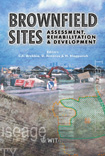Unusual Aspects Of Arsenic Distribution, In The Area Of The Industrial District Of Scarlino (Tuscany): Problems Connected With Sulfuric Acid Production From Pyrite
Price
Free (open access)
Transaction
Volume
55
Pages
Published
2002
Size
545 kb
Paper DOI
10.2495/BF020111
Copyright
WIT Press
Author(s)
M. P. Picchi, L. Fugaro & A. Donati
Abstract
Unusual aspects of Arsenic distribution, in the area of the industrial district of Scarlino (Tuscany): problems connected with sulfuric acid production from pyrite M.P. Picchi, L. Fugaro & A. Donati Department of Chemical and Biosystem Science, University of Siena, Italy Abstract The problem of Arsenic pollution, in the area of an industrial plant for the production of sulfuric acid from pyrite combustion, was studied. The plant is located in a former wetland, close to the sea, in the county of Scarlino, southwest of Tuscany. The main Arsenic source was suspected to be the enormous stocks (1500000 tons) of hematite dust, residue of the pyrite combustion, and the stock of fine particles of pyrite, that were disposed on the soil, close to the plant, without control. The presence of both continuous phreatic and artesian aquifers in the contaminated area, enhance the health risk for the population resident in the district. Analytical data obtained at different depth were collected for Arsenic and other metals and compared with the historical records of the area. Core samples collected in the area, showed a non-regular distribution of Arsenic, regarding both the depth and the distance from the plant. Concerning the vertical distribution, the clay-rich soil, shows that Arsenic concentration reach the maximum peak at different depth from surface, with variable trends. Horizontal distribution, shows a quite regular decreasing in the As concentration going far from the plant, but with the presence of hot spot at the distance of 4-6 km from the industry, where the As level were found very high (As>600mg/kg). In order to understand this behavior, an analysis of chemical data for As and other toxicologically important metals, was proposed.
Keywords




